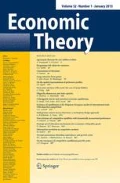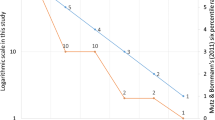Abstract
The evaluation of scientific output has a key role in the allocation of research funds and academic positions. Decisions are often based on quality indicators for academic journals, and over the years, a handful of scoring methods have been proposed for this purpose. Discussing the most prominent methods (de facto standards) we show that they do not distinguish quality from quantity at article level. The systematic bias we find is analytically tractable and implies that the methods are manipulable. We introduce modified methods that correct for this bias, and use them to provide rankings of economic journals. Our methodology is transparent; our results are replicable.
Similar content being viewed by others
Notes
Note that despite the fact that the models are closely related, they lead to very different results: for example, Shoham and Leyton-Brown (2009, Proposition 9.5.1) show that Arrow’s impossibility result holds exclusively in a social choice setting.
Palacio-Huerta and Volij (2004) were the first to introduce invariance properties for scoring methods. However, their properties are not directly related to ours: In Step 3 of Theorem , we show that the invariant method, which they characterize, does not satisfy invariance to article-splitting.
It is well known that a sufficient condition for a matrix to be primitive is to be nonnegative and irreducible with at least a positive element on the main diagonal.
For clarity, we detail the calculations in “Appendix C”.
Note that this professor is only interested in the ranking of his domain and that the links that his domain typically makes/receives are invariant in both cases.
The exact algorithms used by search engines are both a moving target and a black box, but the characteristics to which we make the analogy to here are known to be relatively stable (see for example Langville and Meyer 2006).
Unfortunately, for the time being, metrics based on automatically identified citations using Google Scholar or RePEc just add one more layer of uncertainty, namely collecting genuine citations.
References
Altman, A., Tennenholtz, M.: Ranking systems: the PageRank axioms. In: Proceedings of the 6th ACM Conference on Electronic Commerce (EC-05), pp. 1–8. ACM Press, New York (2005)
Bergstrom, C.T.: Eigenfactor: measuring the value and prestige of scholarly journals. Coll. Res. Libr. News 68(5), 314–316 (2007)
Bergstrom, C.T., West, J.D., Wiseman, M.A.: The Eigenfactor metrics. J. Neurosci. 28(45), 11433–11434 (2008)
Braun, T., Glänzel, W., Schubert, A.: A Hirsch-type index for journals. Scientometrics 69(1), 169–173 (2006)
Brin, S., Page, L.: The anatomy of a large-scale hypertextual web search engine. Comput. Netw. ISDN Syst. 30(1–2), 107–117 (1998)
Cambell, D.E., Kelly, J.S.: Gains from manipulating social choice rules. Econ. Theory 40(3), 349–371 (2009)
Campbell, D.E., Kelly, J.S.: Losses due to manipulation of social choice rules. Econ. Theory 45(3), 453–467 (2010)
Combes, P.P., Linnemer, L.: Where are the economists who publish? Publication concentration and rankings in Europe based on cumulative publications. J. Eur. Econ. Assoc. 1(6), 1250–1308 (2003)
Coupé, T.: Revealed performances: worldwide rankings of economists and economics departments, 1990–2000. J. Eur. Econ. Assoc. 1(6), 1309–1345 (2003)
De Groot, M.H.: Reaching a consensus. J. Am. Stat. Assoc. 69(345), 118–121 (1974)
Garfield, E.: Citation indexes to science: a new dimension in documentation through association of ideas. Science 122(3159), 108–111 (1955)
Golub, B., Jackson, M.O.: Naive learning in social networks and the wisdom of crowds. Am. Econ. J. Microecon. 2(1), 112–149 (2010)
González-Pereira, B., Guerrero-Bote, V.P., Moya-Anegón, F.: The SJR indicator: a new indicator of journals’ scientific prestige. Techical Report, vol. 4141 (2009). ArXiv.org
Hirsch, J.E.: An index to quantify an individual’s scientific research output. Proc. Natl. Acad. Sci. 102(46), 16569–16572 (2004)
Jemec, G.B.E.: Impact factor to assess academic output. Lancet 358(9290), 1373 (2001)
Kalaitzidakis, P., Mamuneas, T.P., Stengos, T.: Rankings of academic journals and institutions in economics. J. Eur. Econ. Assoc. 1(6), 1346–1366 (2003)
Kóczy, L.Á., Strobel, M.: The invariant method can be manipulated. Scientometrics 81(1), 291–293 (2008)
Kóczy, L.Á., Strobel, M.: The world cup of economics journals: a ranking by a tournament method. Iehas Discussion Papers, Institute of Economics, Hungarian Academy of Sciences (2010)
Laband, D.N., Piette, M.J.: The relative impacts of economics journals: 1970–1990. J. Econ. Lit. 32, 640–666 (1994)
Langville, A.N., Meyer, C.D.: Google’s PageRank and Beyond: The Science of Search Engine Rankings. Princeton University Press, Princeton (2006)
Liebowitz, S.J., Palmer, J.C.: Assessing the relative impacts of economics journals. J. Econ. Lit. 22(1), 77–88 (1984)
Marcus, M., Minc, M.: On two theorems of frobenius. Pac. J. Math. 60(2), 149–151 (1975)
Mirrlees, J.A., Neary, P.J., Tirole, J.: Evaluating economics research in europe: an introduction. J. Eur. Econ. Assoc. 1(6), 1239–1249 (2003)
Opátrný, T.: Playing the system to give low-impact journal more clout. Nature 455(7210), 167–167 (2008)
Palacio-Huerta, I., Volij, O.: The measurement of intellectual influence. Econometrica 72(3), 963–977 (2004)
Pinski, G., Narin, F.: Citation influence for journal aggregates of scientific publications: theory, with application to the literature of physics. Inf. Process. Manag. 12(5), 297–312 (1976)
Roy, S., Saberi, A., Wan, Y. (2008) Majorization for the dominant eigenvector of a nonnegative matrix. In: American Control Conference, pp 1965–1966. Westin Seattle Hotel, Seattle
Shoham, Y., Leyton-Brown, K. (eds.): Multiagent Systems. Algorithmic, Game-Theoretic, and Logical Foundations. Cambridge University Press, Cambridge (2009)
Smith, R.: Journal accused of manipulating impact factor. Br. Med. J. 314(7079), 461 (1997)
Sobel, J.: Economists’ models of learning. J. Econ. Theory 94(1), 241–261 (2000)
Zimmermann, C.: Academic Rankings with RePEc. Department of Economics Working Paper Series 2007–36, University of Connecticut, Storrs (2007)
Author information
Authors and Affiliations
Corresponding author
Additional information
An earlier version of this paper circulated under the title “Intellectual Influence: Quality versus Quantity”. We thank Bram Boskamp, Lavinia Gotovan, Çağatay Kayı, András Keszthelyi, Bettina Klaus, Scott Kominers, Itay Fainmesser, Martin Strobel, William Thomson, an associate editor, and an anonymous referee for helpful discussions and comments. Kóczy thanks funding from OTKA (NF-72610), the E.C. (PERG-GA-2008-230879) and the HAS (LP-004/2010). Nichifor thanks funding from NWO (VIDI-452-06-013), METEOR, and SIRE.
Appendices
Appendices
1.1 Appendix A: The complete ranking of economics journals
1.2 Appendix B: Data format and source code
We organized the data in three types of files:
-
the \(m\) file— in this file, for each year \(t\), there is a spreadsheet containing the citation matrix \(C^t\) where an entry in row \(i\), column \(j\), is the total number of cites made in year \(t\) by articles in journal \(j\) to articles in journal \(i\) no older than 4 years;
-
the \(a\) file—in this file, for each year \(t\), there is a spreadsheet containing a column with the number of articles \(a\) published by each journal in that year;
-
the \(c\) file—in this file, for each year \(t\), there is a spreadsheet containing a column with the total number of citations \(c_j\) made by journal \(j\) to articles in journals in \(J\) no older than 4 years.
To obtain the raw ranking vectors from the above matrices, we used the following code in Wolfram Mathematica 8.0:

The diagonal matrices \(A\) and \(D_C\) are generated by our code from the data files. Each year we have a different set of journals: for each year the raw score vectors are copied next to the lists of journals and are normalized. The overall ranking is produced by sorting the journals according to their scores.
1.3 Appendix C: Detailed calculations
Writing Equality 7 in detail for the left most and right most terms of the equality, we obtain the following system of equations:
After canceling terms and dropping the \(j\)th row from the system of equations above, we obtain:
Rewriting the above system of equations using vector and matrix notation yields Eq. 8.
Rights and permissions
About this article
Cite this article
Kóczy, L.Á., Nichifor, A. The intellectual influence of economic journals: quality versus quantity. Econ Theory 52, 863–884 (2013). https://doi.org/10.1007/s00199-012-0708-0
Received:
Accepted:
Published:
Issue Date:
DOI: https://doi.org/10.1007/s00199-012-0708-0
Keywords
- Modified invariant method
- Invariance to article-splitting
- Influence of economic journals
- Impact factor
- LP method
- Invariant method




